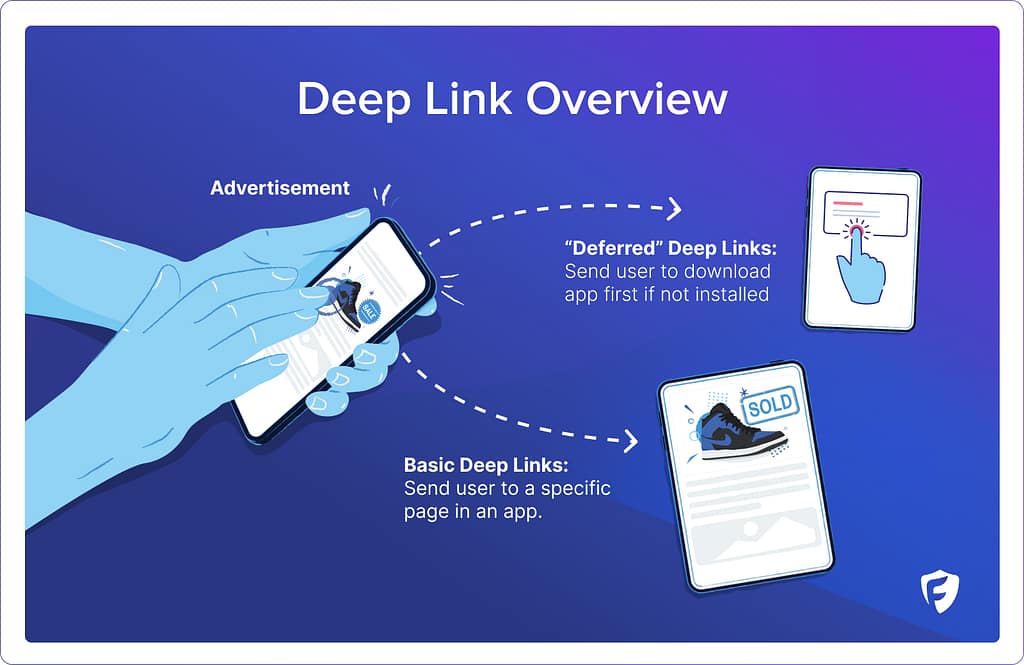What is deep linking?
Deep Linking is the process of creating links that direct users to specific pages or content within a website or mobile app, bypassing other pages like the homepage.
Using deep links can improve user experience by taking a user directly where you want them to go. By sending users directly to relevant content, deep linking can increase leads and conversions, and help you retain more customers by improving user experience.
How does deep linking work?
Deep links work similar to any other link: they direct you to a specific page once you click on them. But unlike traditional links that direct users to a homepage, deep links take you to a particular page, piece of content, or specific screen of a mobile app.
This allows you to send users to specific products, articles, or services, and is very useful for creating targeted campaigns and promotions.
What is the difference between hyperlinks and deep links?
A hyperlink is a link that you might encounter on a web page, document, or email. Hyperlinks are used extensively across the internet to link web pages together. They can also link to email addresses, files, or other types of online resources. Hyperlinks are usually found as underlined and colored text, but they can also be buttons, images, or other web elements. Their primary purpose is to connect different web pages or sections of content, facilitating easy navigation and discovery of information.
Deep links, on the other hand, refer to links that direct a user to a specific piece of content within a website or an application, bypassing the homepage or the initial content. In the context of websites, a deep link will take you directly to a specific page or content within that site, not just the homepage. In mobile applications, deep links can open a specific page or screen in the app, even if the app is not already running or the page is publicly available and seen in Google search results.
What does a deep link URL look like?
Traditional URL Hyperlinks:
Deep Links:
- https://app.fraudblocker.com/integrations/fraud-blocker-tracker
- https://www.etsy.com/your/purchases/3121493887 (this goes to an order summary page; link won’t work for you)
- https://www.zillow.com/homedetails/116-Krameria-Street-Denver-CO-80220/13396916_zpid/
What are examples of deep linking?
1. Nike: Flash Sale on Jordan Sneakers
Rare Jordan sneakers can often sell out in minutes. By using deep links in their promotions, users can be sent from the ad directly to the page to buy the shoes. If deep links weren’t used, then the user may arrive on a less relevant page, need to surf around to find the deal, and ultimately miss out on their time-sensitive purchase.
2. Real Estate Open House Promotion
A real estate company can use deep linking in their digital ads to promote an open house event. The ads could target individuals searching for homes in a specific area, with the deep link taking them to a detailed listing page for a property that has an upcoming open house. This direct approach allows interested buyers to access all the information they need about the property and the event in just one click, enhancing the user experience and increasing engagement with the listing.
3. Hot NFT Release
NFTs are digital collectables that were very trendy in 2022 and 2023. To buy an NFT, users needed to navigate a difficult online world and deep links directly from the company’s website to their NFT collection on OpenSea or other NFT marketplaces was critical. This increased sales and avoided phishing scams that had incorrect links to other unaffiliated collections.
4. Tesla: Launch of their Cybertruck
Tesla can effectively utilize deep linking in their digital marketing campaign for the launch of a their new Cybertruck. For instance, they can create an ad highlighting the unique features of the truck, and the deep link in the ad would direct potential customers directly to a detailed page showcasing the truck, complete with specifications, pricing, and a virtual tour. This allows potential buyers to skip general information and delve right into exploring the specific model they’re interested in (I ❤️ the new Matte black version!)
5. Fitness Apps: New Year’s Resolution Promotion
A fitness app can use deep linking for a New Year’s resolution promotion, targeting individuals looking to start their fitness journey. The ad could focus on a new feature or workout program designed for beginners, with the deep link directing users directly to the program’s signup or introduction page within the app. This approach is particularly effective in capturing the interest of potential new users at a time when they are most motivated to begin a fitness regimen, providing them with a straightforward path to get started.
Advantages of deep linking
Enhanced User Experience: The biggest benefit to deep links is streamlining the user journey and providing a seamless transition from one platform to another. Example: a deep link from an email or social media post can take users directly to the targeted content in your mobile app, instead of a user needing to click from email to website to mobile app.
Increased Engagement: By leading users directly to relevant content, deep linking reduces the steps a user must take, thereby increasing the likelihood of engagement and conversion.
Improved SEO Rankings: Search engines favor websites offering a good user experience. Deep linking contributes to this by reducing bounce rates and increasing time spent on the site.
Effective Marketing and Retargeting: Deep links can be used in marketing campaigns to direct users to specific products or offers, enhancing the effectiveness of advertising efforts.
Tips when creating deep links
Check Compatibility Across Platforms: Deep links should function seamlessly on both desktop and mobile platforms, providing a consistent experience for all users.
Use Descriptive URLs: URLs should be intuitive and descriptive, indicating the content they lead to, which aids in SEO and user understanding.
Test Deep Links Regularly: Regularly test your deep links to ensure that all deep links function correctly and lead to the intended content, maintaining a high-quality user experience.
Integrate with Analytics: Track the performance of deep links through your analytics provider. This will help you understand user behavior and optimize future linking strategies.
Deep linking to mobile apps
In mobile apps, deep linking is a vital tool to enhance user engagement. It allows for links that direct users not just to the app, but to specific content or pages within the app. This is particularly useful in re-engaging users, promoting specific features or content, and streamlining the user experience.
Types of deep links for mobile apps:
Basic Deep Links: These links direct users to specific content within an app but require that the app is already installed.
Deferred Deep Links: These can direct users to specific content even if the app is not yet installed, prompting an install before taking them to the desired page.
Universal Links: These are links that work across both web and app platforms, providing a seamless user experience.





